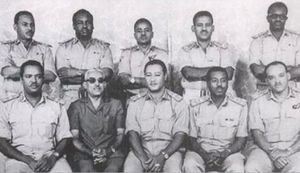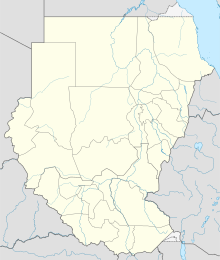الانقلاب السوداني 1969
| الانقلاب السوداني 1969 | |||||||
|---|---|---|---|---|---|---|---|
| جزء من الحرب الأهلية السودانية الأولى والحرب الباردة العربية | |||||||
 أعضاء المجلس الوطني لقيادة الثورة. | |||||||
| |||||||
| المتحاربون | |||||||
| حركة الضباط الأحرار، القوات المسلحة السودانية | |||||||
| القادة والزعماء | |||||||
|
رئيس السودان رئيس وزراء السودان |
جعفر نميري من الضباط الأحرار | ||||||
الموقع في السودان. | |||||||
الانقلاب السوداني 1969، هو انقلاب ناجح، تحت قيادة العقيد جعفر نميري، على حكومة الرئيس إسماعيل الأزهري. كان الانقلاب بمثابة نهاية للفترة الديمقراطية الثانية في السودان، وشهد بداية حكم نميري الذي امتد 16 عاماً.
انتهجت حكومة نميري برنامجًا قوميًا يساريًا عربيًا راديكاليًا، وتبنت برنامجًا اشتراكيًا للتنمية الاجتماعية والاقتصادية، بما في ذلك تأميم واسع النطاق للملكية الخاصة. كما دفعت حكومته من أجل إنهاء الحرب الأهلية السودانية الأولى، والتي كانت مستمرة بحلول عام 1969 لما يقرب من 14 عامًا. سعياً لتحقيق السلام، ضغطت الحكومة الجديدة من أجل العفو، وأعلنت الحكم الذاتي الإقليمي لجنوب السودان في 9 يونيو 1969.
الانقلاب
The coup began early on the morning of 25 May, and by 4:00 am the key installations in the Khartoum-Bahri-Omdurman area had been occupied and leading Sudanese Army generals arrested. At 7:00 am, Radio Omdurman broadcast recorded speeches by Nimeiry and Babiker Awadalla, setting out their plans for government. Radio Omdurman would later that morning also broadcast the names of the members of the new Council of Ministers, who had been agreed on 23 May in a meeting between Awadalla and the 6 key officers.[1]
Whilst the composition of the ruling Revolutionary Command Council had been planned in advance, during the course of the day the council's membership was expanded. Whilst his fellow Free Officers were visiting key Army units and Security organisations to ensure their loyalty to the new regime, Nimeiry met with two members of the Free Officers who had voted against the coup at the Officers April meeting; Lt. Col. Babikir al-Nur and Maj. Abu al-Qasim Hashim. Both had their respective power bases, with al-Nur being the highest-ranking officer associated with the Sudanese Communist Party, and the latter maintaining key links with civilian Arab nationalists and Nasserists. Nimeiry, without consulting with the other coup plotters, decided to bring both individuals into the new government in order to expand its support base. Another officer associated with the communist party, Hashem al Atta, was also brought into the new council. The new council would therefore be composed of not only those who had implemented the coup, but also representatives of the majority block of the Free Officers Movement; which had opposed the coup in April.[1]
انظر أيضاً
المصادر
- ^ أ ب Niblock, Tim (August 1987). Class and Power in Sudan: The Dynamics of Sudanese Politics, 1898-1985. p. 240. ISBN 9780887064814.
